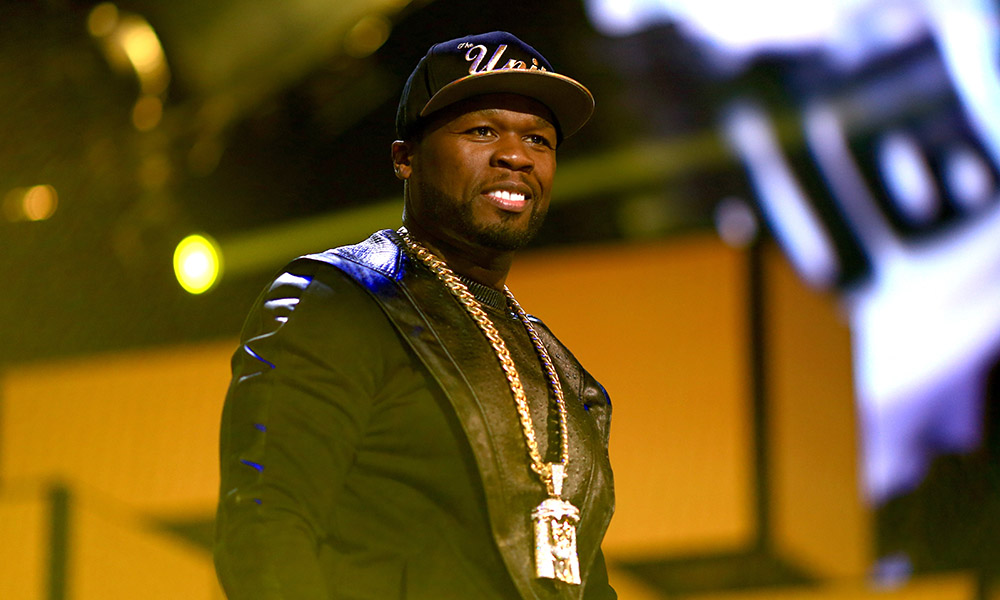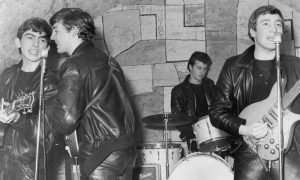50 Cent dominated the charts and music media in the early 2000s. In 2003, the same year Jay-Z announced his “retirement,” the Jamaica Queens native dropped the nine-times platinum Get Rich Or Die Tryin’. At his peak, 50 Cent probably appeared on more than 50 magazine covers (over a dozen XXL covers alone).
After a decade-plus of hustling on various blocks, Curtis Jackson entered the rap game with 1999’s “How to Rob.” A hilarious account of how he’d rob every popular rapper from Jay-Z to DMX, it garnered 50 a massive amount of attention. After he turned in his Columbia debut Power of a Dollar, however, he was shot nine times. Columbia dropped 50 and shelved the album in fear, but the shooting ended up a cruel blessing. In a genre that prizes authenticity and adversity, the shots that nearly killed 50 made him a living legend.
After his recovery, 50 gifted bodegas and bootleggers with a torrent of G-Unit mixtapes and brokered a deal with Eminem (Shady Records) and Dr. Dre (Aftermath Entertainment) for a new debut. At the time, this partnership was the equivalent of being drafted number one to a championship-winning team. No rapper and producer held more sway at that moment. 50 called himself “King of New York” on his mixtapes, but signing with Em and Dre was his true rap coronation. Get Rich or Die Tryin’ was his entrance music.
From the opening sound of two quarters hitting the table until the end of the record, it was clear that 50 studied music as well as he’d studied the streets. His gift for hooks was unmatched. Get Rich or Die Tryin’ had five charting singles. More importantly, every song has a theme or intended audience. Even though he didn’t smoke, he made “High All the Time.” He made club hits that still sounded gangster (“In Da Club”) and dramatized his nearly fatal shooting (“Many Men”). He asked the ladies “21 Questions.” The lyrics were clever, but never too clever. It’s resonant and slick, East Coast but with an almost Southern lilt. Grimy sometimes, smooth at other times. In short, it’s one of the most versatile debut rap albums you’ll ever hear.
50 Cent followed his Shady/Aftermath debut with two more platinum albums, The Massacre and Curtis. But even if each subsequent album brought diminishing chart returns, there have always been flashes of what made 50 Cent one of the best street rappers to ever come out of New York. This introduction to 50 Cent’s best songs offers an insight into what made him so special.
Listen to 50 Cent’s best songs on Apple Music and Spotify.
50 Cent In The Club
(Wanksta, In Da Club, Disco Inferno, I Get Money, Ayo Technology)
50 Cent likely spent more time in the studio and the gym than the club. Yet his music blared from club speakers constantly for much of the early 00s. He made songs for the folks that demanded bottle service, and those dancing near those tables. Blessed with an ear for big, anthemic beats, 50 Cent possessed a gift for writing pop rap, riding the beat with simple yet memorable verses and infectious hooks.
In the midst of his post-Columbia mixtape era, 50 began polishing his gritty thug past for the charts. “Wanksta” originally appeared on the G-Unit mixtape No Mercy, No Fear, but it hit the Billboard Hot 100 when it was re-released on the 8-Mile soundtrack. The beat for “Wanksta” sounds like a chromed-out ice cream truck, nostalgia for popsicle-promising music reworked to make it bang in Jeeps and rooftop bars. (It’s the same formula that made Nelly’s “Country Grammar” work.) The instrumental softens the fact that, between sexual conquests, 50 is threatening adversaries with a 9-millimeter, a Beretta, an AK, and an AR-15. As long as 50 isn’t talking to you, of course, you feel comfortable dancing.
“In Da Club” remains the standard by which all 50 Cent club songs are judged. It was a premature victory lap, one that presaged Get Rich or Die Tryin’ going multi-platinum. Dr. Dre and Mike Elizondo’s beat almost sounds too aggressive for the club, but it works because 50’s voice is slick and melodic. He glides and smirks while rapping about women taking drugs, drinking champagne, and rolling with 20 knife-carrying compatriots. 50 “switch[ed] his style up” (i.e., made club records instead of mixtape cuts), and people have been yelling “Go Shorty, it’s your birthday” ever since.
After Get Rich or Die Tryin’, 50 Cent continued his club dominance for years. On 2005’s “Disco Inferno,” 50 devoted the hook to twerking, but he spends as much time reminding you of his market-tested approach to singles (“The flow sound sick over Dre drums, n—a / I ain’t stupid, I say Doc then my doe come quicker”). On 2007’s Curtis, 50 dropped two more club hits: “I Get Money” and “Ayo Technology.” On the former, he reminds you of the historic Vitamin Water sale that made him a multi-millionaire and flaunts his lifelong wealth. The latter is Zapp’s “Computer Love” reimagined for the strip club with Justin Timberlake and Timbaland.
50 Cent As Lover
(Candy Shop, Just a Lil Bit, P.I.M.P., 21 Questions, Best Friend)
50 Cent contains multitudes. Listen to certain portions of his catalog and it seems he’s only moved by money and retribution. You can hear the former on “P.I.M.P.”, where he plays the decades-old role of ice-hearted mack. He wants money from women and nothing else, making that cold sentiment irrepressibly catchy over Mr. Porter’s Carribean-flavored beat.
But there are flashes of 50 Cent’s sensual and sensitive sides in his oeuvre. “Candy Shop” and “Just a Lil Bit” – both Scott Storch productions that appeared on The Massacre – are pure lust packaged for the club. On “Candy Shop,” 50 moves from bottle popping to the bedroom while extending the titular euphemism like a lascivious Willy Wonka. “Just a Lil Bit,” however, strips back all metaphors as he tells the intended that he wants her to strip “just a lil bit.”
Backed by Storch’s quasi-Bollywood suite, 50 seduces by suggesting progressively more erotic activities. He sells it so well that you almost don’t question lines like, “My mama gone, you can spend the night.” A subtle marketing move, 50 Cent was 30 years-old and a millionaire at this point. But he knew half his audience was probably attending after school clubs rather than turning up at the club.
“21 Questions,” meanwhile, is one of rap’s best love songs. The late Nate Dogg sings the central question on the hook: “Would you love me if I was down and out?” 50 Cent spends the rest of the song exploring a variety of hypothetical worst-case scenarios with his partner. It’s a tender display of vulnerability (and possibly insecurity) that’s become a classic. Released on the Get Rich or Die Tryin’ soundtrack, “Best Friend” plays like a prelude to “21 Questions.” Rather than worrying about the authenticity of his partner’s love, 50 courts a would-be partner. It’s affectionate and seemingly sincere, arguably one of the few times on record where 50 put his heart on the line.
50 Cent As Hustler
(How to Rob, Many Men, Ski Mask Way, Ryder Music, Hustler’s Ambition)
50 Cent’s hustler upbringing is one of his catalog’s dominant tropes, yielding songs that speak to our fascination with gangsters and the societal ills that breed them. 50 has an uncanny ability to turn his past into cinematic songs. He brings you into that world, and speaks to those who were still trying to make it out.
“Many Men (Wish Death)” begins with a reenactment of the night where he almost lost his life. What follows is a piano-driven dirge where 50 asserts his rap dominance before discussing the nightmare-inducing paranoia and squeeze-first mentality it engendered. He directly addresses those on the block and behind bars before summarizing the racial injustices of a carceral system that could’ve sentenced him to another death. Haunted and brilliant, “Many Men (Wish Death)” works without the backstory; knowing that 50 survived nine shots makes each line weigh even heavier.
Though 50 Cent grappled with personal pain and fear, he made many songs about inflicting them on others. There are tracks like the celebrity-listing “How to Rob,” which plays out like stick-up kid fantasy. Then there’s “Ski Mask Way” from 2005’s The Massacre, where, on the hook, he turns robbing someone at gunpoint into a standup routine: “That chain is nice, that’s what you bought for me? / Them earrings is nice, that’s what you bought for me?” In the verses, 50 is taking people hostage and robbing the stash house. Those days were long in the rearview at that point in 50 Cent’s life, but he seemed nostalgic for the memories.
Features
(“Magic Stick,” “Hate It or Love It,” “How We Do,” “Hate Bein’ Sober,” “The Woo”)
In the early-to-mid 2000s, 50 Cent features were the equivalent of a Drake guest verse in the 2010s. It was an endorsement from one of the biggest rappers in the world. Back then, at the peak of G-Unit, he rarely collaborated with people outside of his circle or New York. First and foremost, there was “Magic Stick,” where he and Lil Kim bragged about their respective sexual prowess. But 50 Cent had far more songs with The Game.
Before he and 50 Cent had a falling out, The Game was G-Unit’s lone West Coast member. 50, clearly interested in The Game’s success, handled the hooks for the first three singles from Game’s 2005 debut, The Documentary. It was the perfect pairing: 50 Cent’s pimp-like lilt and drawl juxtaposed with the Game’s deep and aggressive rasp. The best of their collaborations remains the Dr. Dre-produced tracks: “How We Do” and “Hate It Or Love It.”
“How We Do” finds 50 floating over dark, drum-heavy post g-funk bounce. Every syllable is smooth, effortlessly delivered as he celebrates his new wealth and lambasts the old money crowd like a gangster Jay Gatsby: “They call me new money, say I have no class / I’m from the bottom, I came up too fast / The hell if I care, I’m just here to get my cash.” On “Hate It Or Love It”, though, 50 gets more personal than he does on perhaps any other feature in his catalog. He opens the song with a truncated biography that extends from his adolescent confusion surrounding his mother’s sexual orientation to selling drugs and hoping to make it out of the hood.
As 50 Cent slowed his solo output, he became more selective in choosing his collaborators. In 2012, he worked with Chicago drill luminary Chief Keef on “Hate Bein Sober,” while 2020 saw him appear on Pop Smoke’s posthumously released “The Woo,” rapping about sex on exotic vacations.
Think we missed one of 50 Cent’s best songs? Let us know in the comments below.




